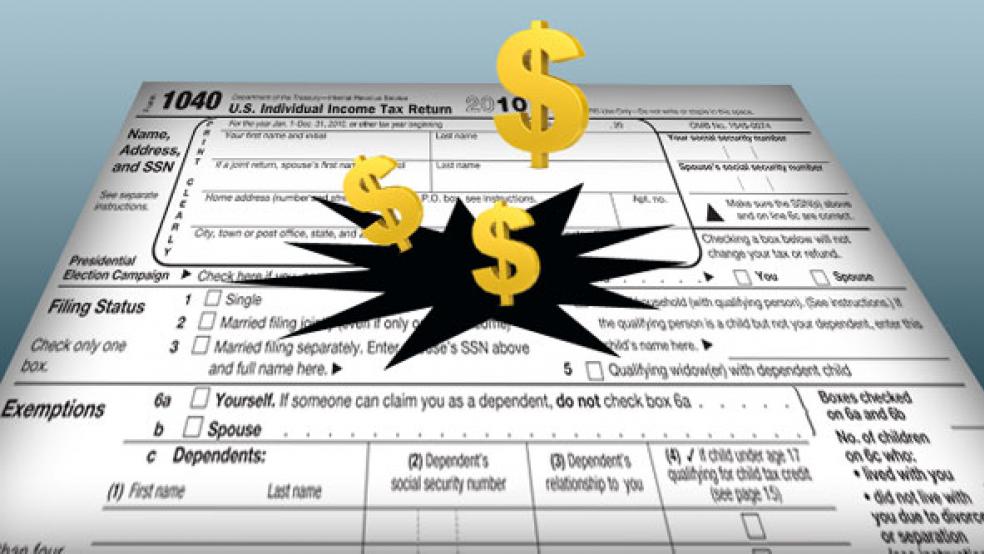No part of the fiscal cliff could body slam the middle class quite like the Alternative Minimum Tax—stamping on average another $1,800 onto to the 1040 forms of 28 million Americans for this year.
The AMT was first introduced 43 years ago to ensure the wealthy couldn’t escape the IRS with write-offs and tax shelters. Maybe this idea sounds like something you’ve heard about recently? President Obama secured reelection by calling for more economic fairness, and multi-billionaire investor Warren Buffett championed a “minimum” tax rate this week in a New York Times op-ed for those making more than a million dollars a year.
These proposals largely exist because the AMT—a parallel tax system that eliminates several deductions and credits—never fulfilled its mission. The rich found new loopholes to exploit, as this catch-all evolved into a budgetary headache because it wasn’t indexed for inflation. With each passing year it burrows deeper and deeper into the middle class, so to stop that from happening Congress usually approves an AMT patch—even though it’s recently struggled to do so.
But for this year, a patch that would prevent the AMT from hitting families with incomes as little as $74,450 has yet to get through Capitol Hill. It’s been lumped in with the fiscal cliff of $600 billion in tax hikes and automatic spending cuts that are scheduled to occur next year.
“The AMT and the Buffett rule are band-aids on a dysfunctional tax code that in fact make the problems of complexity and opacity much worse,” William McBride, chief economist for the Tax Foundation, told The Fiscal Times. “The solution is to simplify the code.”
It’s generally assumed that lawmakers will keep this particular $90 billion economic time bomb from detonating. But the clock is ticking without visible signs of progress on a cliff deal that requires Democrats to reduce entitlement spending and Republicans to support tax increases.
Unless there’s an agreement soon, more than a third of all taxpayers will undergo sticker shock upon seeing what they owe Uncle Sam. The total number of Americans exposed to the AMT would balloon from slightly more than four million to 33 million.
About 45 percent of families earning between $75,000 and $100,000 would fall under the AMT, compared to four-tenths of a percent of them in 2011, according to the Tax Policy Center. It would also strike 81.3 percent of Americans making $100,000 to $200,000, versus just 3.5 percent before. Amazingly, only half of those with incomes above $1 million would be subject to the AMT.
Acting IRS Commissioner Steven Miller warned in a letter this month to Senate Finance Committee Chairman Max Baucus, D-Mont., that further inaction on the patch would lead to delays in refunds and 60 million Americans not being able to file their taxes until late March.
“Tens of millions of these taxpayers would unexpectedly have to pay additional income tax for 2012, leaving them with a balance due return or a much smaller refund than expected,” Miller wrote.
So why not just fix the AMT for 2012 and remove it from the fiscal cliff?
The working theory is that it helps Republicans in negotiations, since voters in Democratic-heavy states like California and the eastern seaboard would endure most of the pain from a hole in the AMT. All ten of the states whose population had the greatest AMT burdens last year voted for Obama.
“The AMT is an issue that Republicans think is more important to Democrats than it is to them,” explained Jonathan Traub, a former staffer on the House Ways and Means Committee and now a managing principle at Deloitte Tax. “You can imagine that Republicans might want to withhold action on the AMT to get action on other parts of the fiscal cliff.”
Or, better yet, why not just peg the AMT to inflation going forward?
That would screw with the official baseline the Congressional Budget Office uses to assess deficits over the next decade. The CBO relies on “current law,” which assumes there is no patch and money generated by the AMT gets collected in the years ahead.
Permanently indexing it to inflation would slash the revenue projections and add about $1.1 trillion to the national debt in the next decade. This conflicts with the goal of the fiscal cliff negotiations—to trim about $4 trillion from estimated budget deficits over the same period.
Congress enacted the AMT in 1969, after a report showed that 155 Americans with incomes above $200,000 (more than $1 million today) paid no income tax. It proved less than effective. A 1976 Treasury Department study found that 244 people earning more than $200,000 still avoided all federal income taxes in 1974.
But here’s the real dilemma posed by the AMT. If it tumbles off the fiscal cliff, lawmakers have few ways to limit the damage, unlike the $109 billion in sequestered budget cuts and the expiration of the lower tax rates originally passed by President George W. Bush. The IRS would need to engage in substantial design and engineering work to change its collection systems if the ATM isn’t tailored for inflation.
Traub summarized the problem confronting lawmakers if 2013 begins without a patch in place, “It would be really hard to put that toothpaste back in the tube.”




